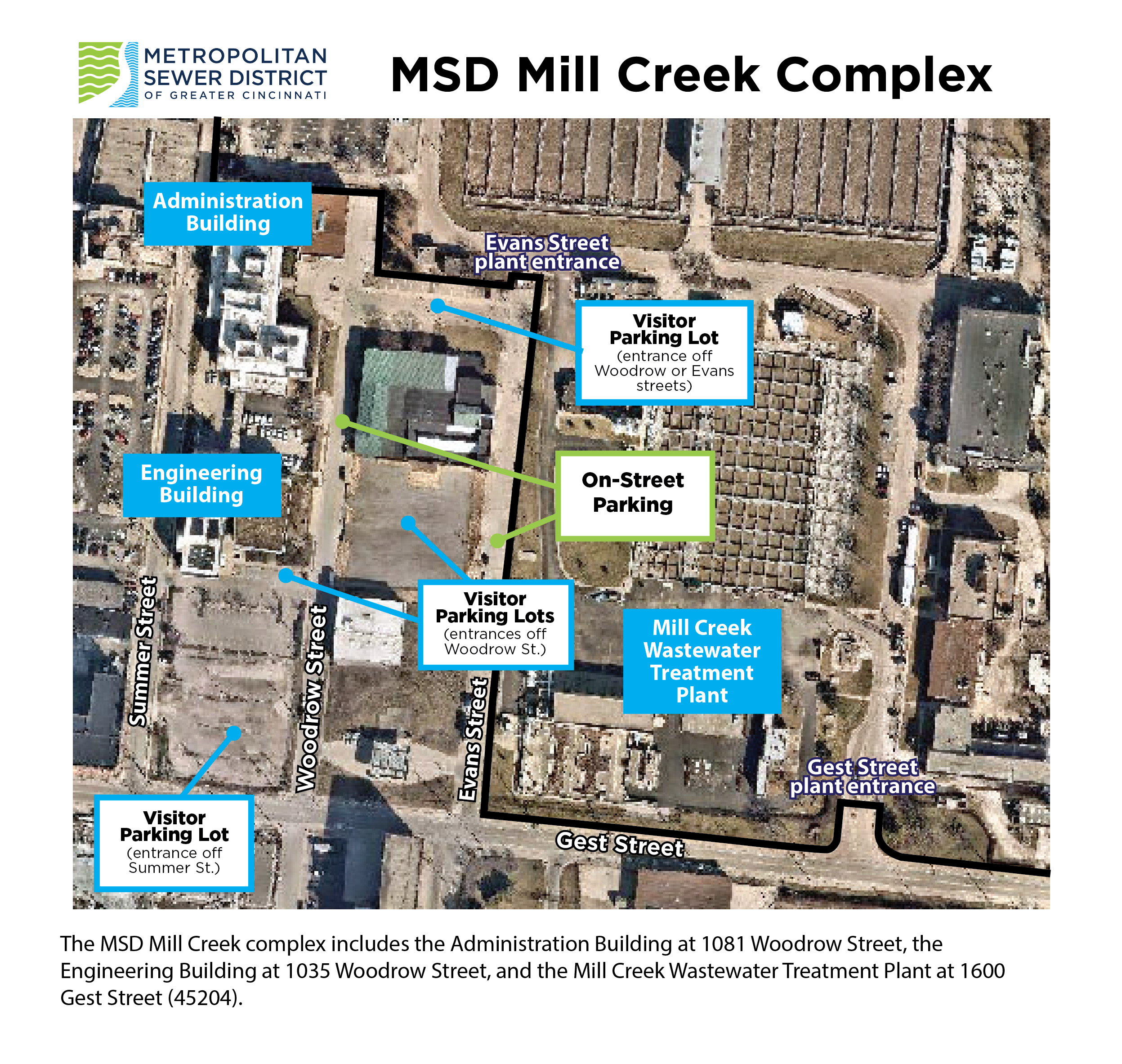MSD Facilities
MSD operates facilities throughout Hamilton County to serve its customers.
MILL CREEK COMPLEX
Mill Creek is MSD's largest complex located in Lower Price Hill, west of downtown Cincinnati. It includes:
- MSD Administration Building, 1081 Woodrow Street, Cincinnati, OH 45204. The Administration Building is home to the Office of the Director, IT, Wastewater Administration, and Compliance Services divisions.
- MSD Engineering Building, 1035 Woodrow Street, Cincinnati, OH 45204. The Engineering building is home to the Wastewater Engineering division. This division plans, designs and constructs our wet weather and asset management projects. Development Services is also located at the front of this building through a separate entrance.
- Mill Creek Wastewater Treatment Plant, 1600 Gest Street, Cincinnati, OH 45204. The Mill Creek WWTP, which began operations in 1959, is MSD's largest plant, treating about 100 million gallons of wastewater a day. The plant serves customers in central Hamilton County, from the northern county border to the Ohio River.
WASTEWATER COLLECTION
The Wastewater Collection facility is responsibile for operating and maintaining MSD's 3,000 miles of public sewers. The facility also responds to customer service calls about sewer backups, sewage surfacing, cave-in (sinkholes), and odors.
- Wastewater Collection Facility, 225 W. Galbraith Road, Cincinnati, OH 45215.
OUTLYING FACILITIES
MSD operates 8 outlying treatment plants (including two package plants), three high-rate treatment facilities, and nearly 100 pump stations:
- Fort Scott Package WWTP in Crosby Township - The Fort Scott package plant serves customers in the Fort Scott subdivision in Crosby Township in western Hamilton County. The plant was built in 2006-2007 and MSD assumed operation in 2008. This plant treats about 45,000 gallons a day.
- Indian Creek WWTP in North Bend - The Indian Creek plant serves customers in the Cleves and North Bend communities in southwestern Hamilton County. Indian Creek has been in operation since 1995 as a major plant and treats about 1 million gallons a day. It was originally constructed in 1935 as a Works Progress Administration (WPA) project.
- Little Miami WWTP in the East End - The Little Miami plant serves customers in much of eastern Hamilton County. As MSD's first major treatment facility, Little Miami WWTP has been in operation since 1953 and treats about 27 million gallons a day.
- Mayflower Package WWTP in Pleasant Run - The Mayflower package plant serves about 200 customers in the vicinity of Overdale Drive in Pleasant Run. The plant was built in the esrly 1970s and treats about 45,000 gallons per day.
- Muddy Creek WWTP in Sayler Park - Muddy Creek WWTP serves customers in portions of southwestern Hamilton County. Muddy Creek has been in operation since 1961 and treats about 15 million gallons a day.
- Polk Run WWTP in Loveland - Polk Run WWTP serves customers in the Loveland area. Polk Run has been in operation since 1970 and treats about 4 million gallons a day.
- Sycamore WWTP in Symmes Township/Indian Hill - Sycamore WWTP serves customers in portions of eastern Hamilton County. Sycamore has been in operation since 1958 and treats about 8 million gallons a day.
- Taylor Creek WWTP in Cleves - Taylor Creek WWTP serves customers in northwestern Hamilton County. Taylor Creek has been in operations since 1997 and treats about 2.5 million gallons a day.
- Werk & Westbourne Enhanced High-Rate Treatment (EHRT) Facility in Green Township - The Werk & Westbourne EHRT has been in operation since 2018 and treats excess wastewater flows during wet weather.
- Muddy & Westbourne High-Rate Treatment (HRT) Facility in Green Township - The Muddy & Westbourne HRT has been in operation since 2001 and treats excess wastewater flows during wet weather.
- SSO 700 Storage Treatment Facility (STF) in Reading - The SSO 700 STF has been in operation since 2007 and treats excess wastewater flows during wet weather.
- Pump Stations located through Hamilton County - MSD’s pump stations are installed, typically by subdivision developers, at low points in the collection system and are used to pump wastewater to a higher elevation so it can flow by gravity again to a treatment plant.
